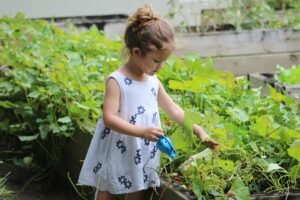Gardening Tips for Small Backyard Spaces

Many people find it very difficult to start a garden, but it does not have to be that way, especially if you have a small backyard to start with. Whether you plan to cultivate flowers or vegetables or just add a touch of green to your compound, how you utilize the space mostly determines your gardening results. Below are good recommendations for growing plants in compact backyards.
1. Organize and establish the importance of the area.
Due to the available space in the backyard being, small planning is important. First, identify what is to be grown and the space requirements for each plant to be cultured. Identify your plants according to your objectives—this could be early table vegetables, lovely flowers, or both table vegetables and flowers. One may decide to sketch the garden area; this is an effective way of planning how each part will be utilized. Think of areas exposed to light most since many plants require light for approximately six to eight hours daily. Grow the plants that require direct sunlight in the areas that could provide them with such conditions and vice versa.
2. Use Vertical Gardening Techniques
Hanging plants is among the most efficient ways to make the most of the small space available. Vertical gardening is growing plants on walls, trellis, and hanging structures to maximize available soil space. Wall planters can be mounted on fences or house walls, and you can grow edibles such as herbs, strawberries, and flowers that hang. These are ideal for climbing plants such as cucumbers, tomatoes, and beans. Vertical gardening provides more effective use of the ground area and brings more elements of aesthetic appeal into gardens, transforming them into unique three-dimensional green zones.
3. Select Small Plant or Miniature Plant Varieties
Choosing small types of plants or curving them into small sizes is another good strategy when gardening in a small backyard. Most vegetables and ornamental plants have small varieties that produce even more or are at par with larger ones. For example, bush tomatoes, dwarf peppers, and baby carrots do well in small yards and require less growing space. Likewise, tiny roses, small lavender, or other shrubs that are not too large can also be planted to make your backyard beautiful. When the plants selected are appropriate to the area’s size, neatness and tidiness of the garden are achieved.
4. Try Container Gardening
This type of gardening is suitable in little backyard spaces primarily because of its many benefits, including flexibility and mobility. Containers help you take plant growing to regions where you may not consider making standard garden beds. It is possible to put containers on patios near the pathways or steps. Select different sizes to accommodate different plants, the diminutive herbs, and the more expansive vegetables. You must ensure the pots you choose have drainage outlets to avoid water logging. Other benefits associated with container gardening include rearranging the pots and the plant containers to capture light or shield plants from harsh weather conditions.
5. Build Raised Garden Beds
Gardening on raised beds could easily be considered a good idea for a small garden since it not only delimits the garden and the surrounding space but also facilitates the work done in the garden. These beds can be constructed in any size and height, so you form the soil and its drainage capacity to your specifications. Some benefits of raised beds include the following: Raised beds are most suitable for vegetables, herbs, and flower production in most people’s small backyards. If you still have small space on the ground, you can fix your raised beds, one on top of the other, in a manner that looks like a step garden. This makes some space and brings a little bit of eye-catching feature in the backyard area.
6. Using an available space to the hilt through Companion Planting
This is a form of crop interrelation whereby you cultivate plants in a manner that produces the most from a given area of land, enriches the soil, or defends against pest invasions. In this kind of garden, which is usually found in small backyards, this technique lets you optimize the space in the garden. For instance, you can plant crops that grow faster, such as lettuce or radish, together with crops that take longer to grow, such as tomatoes or pepper. The plants will be harvested when they start growing fast before the slow-growing ones require even more growing space. Furthermore, surrounding tomatoes with herbs such as basil helps to enhance their growth and taste, besides the fact that marigold flowers repel some common pests in the garden.
7. Incorporate Multifunctional Furniture
If your yard is very small, you may need to include multifunctional garden furniture. Built-in planters, convertible tables that can also be used as shelving, or garden seating that also serves as elevated garden beds means the space can double up for gardening and relaxation. While gardening and making functional outdoor furniture, you get an opportunity to make your backyard more useful and fun. This is particularly useful if you prefer your small area to be used as a dining or entertainment area.
8. Maintain a Minimalist Approach
Therefore, there must be restraint in using the available space in a more compact backyard design, and the designs used should be quite simple. Minimal gardening is a concept that involves less work and overall space but concentrates on quality. First, you have to decide on which structures or few plants are important, and other elements of your garden should complement them. For example, choose one or two shrubs, for instance, a tree or a flowering shrub, and then surround it with matching greens. This way, not only does it free up the backyard space, but it also returns a beautiful and orderly garden that does not require much maintenance. Trimming plants, competition of unwanted plants, and compound cleaning will also maintain a neat garden.
Conclusion
Gardening in a small backyard is as fulfilling as it can be a people-friendly occupation with some tricks. So, if one is restricted with space, proper planning, effective use of the height, choosing small and compact plants for planting, and implementing container gardening can lead to a productive and very appealing garden/bed. It applies to vegetables, herbs, or flowers growing in your backyard, and these tips will make gardening a memorable experience for you. The idea is to keep the space as useful as possible, and if you try, you can turn any corner of your house into a mini-garden.
To read more about How to Grow Your Own Organic Garden, click here.



